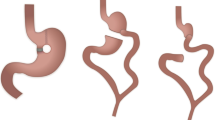Abstract
Duodeno-duodenal intussusception (DDI) is very rarely encountered. A 40-yr old gentleman presented acute abdominal pain and recurrent episodes of bilious vomiting since 5 days. Serum amylase and serum lipase were raised. Upper gastrointestinal endoscopy revealed obstruction in the second part of duodenum with bile stasis and scope not negotiable. Abdominal contrast enhanced computed tomography (CECT) shows 4 × 3 × 3 cm heterogeneously enhancing complex soft tissue mass lesion in proximal duodenum. Exploratory laparotomy was planned. There was duodeno-duodenal intussusception with sessile polyp in posterior wall of second part of duodenum. Pancreatoduodenectomy with feeding jejunostomy was done. Histopathology report suggested moderately differentiated adenocarcinomas.
Similar content being viewed by others
Avoid common mistakes on your manuscript.
Introduction
Intussusception is a condition in which usually proximal part of gut becomes invaginated within an immediately adjacent distal part. It can occur anywhere in the intestine. The duodeno-duodenal intussusception (DDI) is very rarely encountered because the duodenum is fixed onto the retroperitoneum, but seldom possible in the case of malrotation abnormality. In the literature, few cases are reported of duodenal intussusception without malrotation abnormalities [1, 2]. Here, we report a case of DDI secondary to duodenal polyp as a leading point.
Case Report
A 40-yr old non-alcoholic gentleman presented with complaint of intermittent abdominal pain since 8 months, loss of weight, and appetite for the last 4 months. Patient had acute abdominal pain and recurrent episodes of bilious vomiting since 5 days. Physical examination revealed tenderness in the epigastric region and vague lump in the umbilical region. Routine blood investigations and liver function test was normal. Serum amylase and serum lipase were raised.
On ultrasound report, there was duodenal mass. Upper gastrointestinal (GI) endoscopy revealed obstruction in the second part of the duodenum (D2) with bile stasis and scope not negotiable. Abdominal contrast enhanced computed tomography (CECT) showed 4 × 3 × 3 cm heterogeneously enhancing complex soft tissue mass lesion in the proximal duodenum with bulky pancreas (Fig. 1).
Exploratory laparotomy was planned. There was a distended gall bladder and dilated stomach along with the first and the second part of duodenum with intussusception. The first part of duodenum (D1) was traversing into the second part of duodenum (D2) with a 4 × 3 × 1.5 cm size sessile polyp present internally in the posterior wall of D2 occupying one third circumference and 2 cm above the papilla. Pancreatoduodenectomy with feeding jejunostomy was done (Fig. 2a, b).
Drain was removed on the fifth postoperative day (POD) and orally started on the seventh POD. Postoperative period was uneventful, and patient was discharged on the tenth POD after taking solid comfortably. Feeding jejunostomy was removed on the 21st day. Histopathology report suggested moderately differentiated adenocarcinomas. At six-month follow-up, patient was doing well.
Discussion
Adult intussusceptions are uncommon, accounting for only 5% of all cases and differ from children in various aspects, like its presentation, etiology, and management [3, 4].
The leading points in the intussusception can be benign, malignant, or idiopathic cause. Malignancy (primary or secondary) accounts for 6–30% of all cases of intussusception, as in this case in which duodenal polyp was leading point and on histopathology report it turned out into adenocarcinomas [4].
The duodeno-duodenal intussusception (DDI) is very rare. The presenting symptoms are usually non-specific and most cases are diagnosed during surgery. It is commonly manifested with obstructive symptoms, which may be acute, chronic, or intermittent. Other symptoms are abdominal mass, weight loss, and fever. DDI may manifest as obstructive jaundice or pancreatitis if it involves the ampullary region due to obstruction of common bile duct and pancreatic duct [5]. Pancreatitis secondary to DDI is a very rare presentation of duodenal adenoma, as seen in our case which was presented with gastric outlet obstruction and pancreatitis.
Diagnostic modalities used in DDI are usually ultrasound, upper GI endoscopy, upper GI series, and CECT scan [5]. CECT scan is the most reliable investigation in making a diagnosis.
In contrary to children, treatment of intussusceptions in adults is typically surgical resection in view of high incidence of underlying abnormality. Approximately 50% of adult intussusceptions are associated with malignancy [3, 4].
The choice of procedure depends on size and site of lesion and presence of complications [5]. Endoscopic resection is done in small, pedunculated, non-ampullary duodenal tumor. Different surgical resection procedures are transduodenal submucosal excision, local full thickness or partial wedge resection, pancreas sparing segmental duodenectomy, and pancreaticoduodenectomy.
Pancreaticoduodenectomy can be performed in the case of duodenal intussusception secondary to ampullary adenoma due to risk of malignancy. Less invasive procedure like surgical ampullectomy can be considered a treatment for ampullary adenoma, but there is a risk of injury to the pancreatic parenchyma [2].
Duodeno-duodenal intussusception is very rare and there should be high index of clinical suspicious in the case of gastric outlet obstruction and pancreatitis.
References
Gardner-Thorpe J, Hardwick RH, Carroll NR, Gibbs P, Jamieson NV, Praseedom RK (2007) Adult duodenal intussusception associated with congenital malrotation. World J Gastroenterol 13:3892–3894. https://doi.org/10.3748/wjg.v13.i28.3892
Hirata M, Shirakata Y, Yamanaka K (2019) Duodenal intussusception secondary to ampullary adenoma: a case report. World J Clin Cases 7(14):1857–1864
Azar T, Berger DL (1997) Adult intussusception. Ann Surg 226(2):134–138
Yalamarthi S, Smith RC (2005) Adult intussusception: case reports and review of literature. Postgrad Med J 81:174–177. https://doi.org/10.1136/pgmj.2004.022749
Pradhan D, Kaur N, Nagi B (2015) Duodenoduodenal intussusception: report of three challenging cases with literature review. J Can Res Ther 11:1031
Author information
Authors and Affiliations
Corresponding author
Ethics declarations
Conflict of Interest
The authors declare that they have no conflict of interest.
Additional information
Publisher’s Note
Springer Nature remains neutral with regard to jurisdictional claims in published maps and institutional affiliations.
Rights and permissions
About this article
Cite this article
Gupta, S., Bansal, S. Duodeno-Duodenal Intussusception Presenting as Acute Pancreatitis due to Duodenal Adenocarcinomas: a Rare Case Report. Indian J Surg 83, 357–358 (2021). https://doi.org/10.1007/s12262-020-02360-2
Received:
Accepted:
Published:
Issue Date:
DOI: https://doi.org/10.1007/s12262-020-02360-2






